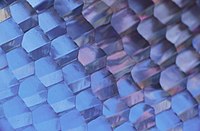Honeycomb structure

Imagine you have a row of little boxes that are all the same size and shape. You want to stack them on top of each other to make a big tower. But you don't want the tower to be too heavy or too weak. So, instead of just stacking the boxes on top of each other, you decide to put them side-by-side and connect them with little walls.
This is sort of like what happens when we make something with a honeycomb structure. The honeycomb is made up of lots of little cells that are all shaped like hexagons (that's a fancy way of saying they have six sides). These cells are connected together with walls that are very thin and light, but also very strong.
The honeycomb structure is great for a lot of things because it's both strong and lightweight. For example, if you've ever seen a beehive up close, you might have noticed that it looks like it's made out of little hexagons. That's because the bees make the honeycomb structure to store their honey and eggs.
But honeycomb structures aren't just for bees. People use them too! For example, honeycomb structures are often used in airplane wings because they can be very strong without being too heavy. They're also used in some kinds of furniture, like bookcases or room dividers, because they can look really cool and modern.
So, next time you see a beehive (or even just a picture of one!), remember that the honeycomb structure is not only important for bees, but also for humans in lots of different ways!
This is sort of like what happens when we make something with a honeycomb structure. The honeycomb is made up of lots of little cells that are all shaped like hexagons (that's a fancy way of saying they have six sides). These cells are connected together with walls that are very thin and light, but also very strong.
The honeycomb structure is great for a lot of things because it's both strong and lightweight. For example, if you've ever seen a beehive up close, you might have noticed that it looks like it's made out of little hexagons. That's because the bees make the honeycomb structure to store their honey and eggs.
But honeycomb structures aren't just for bees. People use them too! For example, honeycomb structures are often used in airplane wings because they can be very strong without being too heavy. They're also used in some kinds of furniture, like bookcases or room dividers, because they can look really cool and modern.
So, next time you see a beehive (or even just a picture of one!), remember that the honeycomb structure is not only important for bees, but also for humans in lots of different ways!
Related topics others have asked about:
